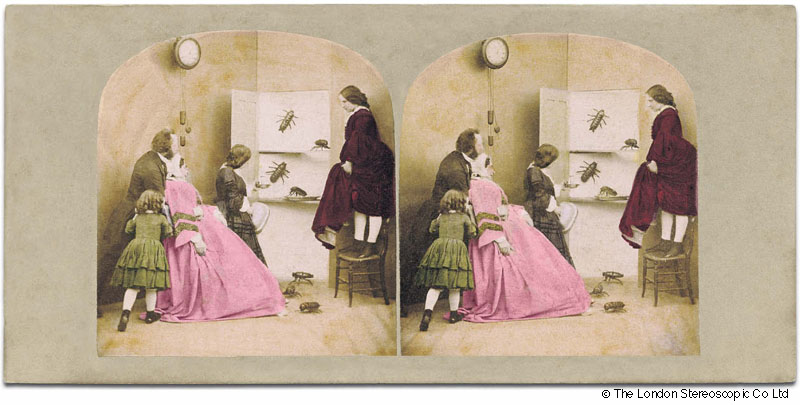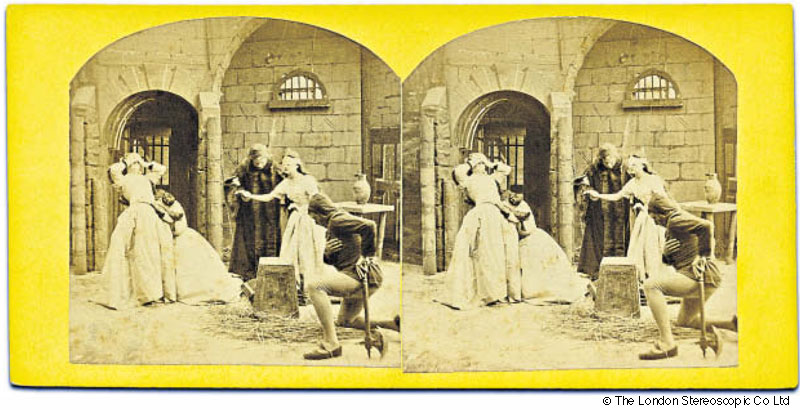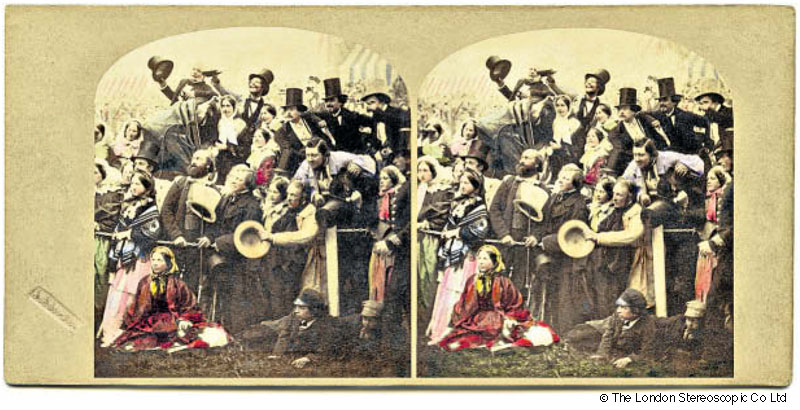A delightful article appeared in Saturday’s Telegraph ahead of today’s book launch of A Poor Man’s Picture Gallery at the Tate:
TELEGRAPH
18 Oct 2014 R16
REVIEW | SATURDAY, OCTOBER 18, 2014
 ‘Awful Discovery’
‘Awful Discovery’
Throughout Queen’s glory years, while Freddie Mercury was, according to one of rock-and-roll’s most notorious myths, inhaling cocaine from the heads of hermaphrodite dwarves, Brian May was sniffing out treasures of a different kind.
As the band toured the world in their spangled suits, the famously poodlehaired guitarist would use his free time to search out stereo photo cards. “I’d nip out of a morning, and buy one or two from local dealers,” he tells me, across a desk cluttered with lava lamps and microscopes in his Berkshire home. “It was a nice thing for me, and I was dedicated. My suitcase would be full of them.”
We’ve climbed several storeys to reach May’s office in the eaves of his Arts and Crafts house, past framed Padi diving certificates and a life-size hologram of May.
Guitars line the upstairs hallway outside his hideout, where a not very rock-androll ironing board perches centre stage. It’s piled high with papers, and surrounded by a jumble of peculiar, gothic-looking eyepieces.
“My geekiness is bottomless when it comes to stereo,” he says, dusting off a stool for me to sit on.
Stereo photography, in which two flat images are fused in a special viewer to produce a scene in 3D, was a Victorian fad. At its height in the 1860s, thousands of stereo cards were produced and sold from the Oxford Street premises of the London Stereoscopic Company (LSC). The majority depicted built or natural wonders – the Pyramids, glaciers, the Crumlin Viaduct in Wales – but the market for sentimental tableaux and supernatural scenes was massive.
In 2008, May – who the previous year had attained a PhD in astrophysics from Imperial College London – brought the long-defunct LSC back to life. His sidekick in this endeavour was fellow enthusiast and scholar Denis Pellerin, a softly spoken, spry Frenchman who moved across the Channel at May’s request to help catalogue and research his collection.
“I had the information,” says Pellerin, “and I had the cards!” chimes May. This month the two men publish their third book. The Poor Man’s Picture Gallery borrows its title from a newspaper article of 1858, in which the writer praises the stereoscope for “placing within the means of a poor household the power of possessing excellent transcripts of nature and works of art”.
The book, which establishes an extraordinary framework of connections between stereo images and the paintings, cartoons and theatre of the day, is published alongside a new display at Tate Britain, in which 12 works from the Victorian and Pre-Raphaelite collection are brought face-to-face with their 3D doubles for the first time.
Stereography was a very accessible form of entertainment. Every middle-class home had a stereo viewer and a stack of cards. You could even hire a viewer for an evening, and borrow cards from a library. The poor could see them at fairs and, at the other end of the spectrum, we know that Queen Victoria herself had several hundred – the London Stereoscopic Company even had a royal warrant.
With its woodchip wallpaper, gadgets and autographed photos, May’s attic office has much the feel of a schoolboy’s bedroom. It’s probably not dissimilar to the one in which he first discovered stereo, thanks to the VistaScreen cards he collected from Weetabix packets as a child. “I found it magical,” says May, who is dressed in a Foo Fighters T-shirt, shorts and trainers, with a pair of tortoiseshell glasses dangling from a chain around his neck. “I was in my own world with a stereoscope. It’s like having earphones on – you’re completely in contact with your subject matter.”
While we’re here, Pellerin surprises May by presenting him with a set of VistaScreen cards featuring Sixties hero Sam Sawyer. “He rockets back to Earth with captured moon!” reads May aloud, the red plastic viewer stuck fast to his grinning face. “I had this one when I was a kid.”
Stereoscopy works by replicating human vision. Although if you cover one eye, it seems as if you are still seeing in 3D, in fact this is mostly an illusion. Our brains have been trained since childhood to recognise depth using clues such as shadows, but try capping a pen with one eye closed and you’ll discover your loss of perspective makes the task far from easy.
The scientist in May can’t help himself. “It’s called parallax,” he says. “It means your right eye will always see a slightly different version of the truth than your left eye, but your brain puts these together and constructs a 3D image. It happens millions of times a day – it’s a miracle, and we take it completely for granted.”
As a child, May went from collecting stereo cards to making his own. “I had an appetite for that stuff,” he says. “So I took my two and sixpenny Woolworth’s camera and took two pictures of my bike. I stuck them on cardboard and put them in the Weetabix viewer and it worked.”
It’s important to note that the versions of paintings the Victorian stereo photographers produced were physical recreations. They would advertise for models, or use their friends and family, inviting every “character” to their studio to be photographed together. With a painting such as Francis Frith’s Derby Day, populated with hundreds of people, this was no mean feat.
Among the jewels of May’s collection are two unique daguerreotype stereos: one of Queen Victoria’s daughter Vicky on her wedding day; another – which May hands me – taken inside the original Crystal Palace. “The one you’re holding could have been bought inside the Palace itself,” he says. “Actually no, this one is French,” corrects Pellerin. But even so, looking at the original Crystal Palace through Victorian eyes is quite something: it truly feels as if you’ve stepped inside the long vanished building.
Next on the agenda for the London Stereoscopic Company is a book on stereo photos of crinolines – a hugely popular subject for Victorian photographers, who liked to joke about their capacity to hide lovers from husbands, catch fire and render their wearer incapable of entering omnibuses.
May also plans to publish a book of the stereo photos he took on tour with Queen. They date back to the band’s Radio Ga Ga days. “Sometimes I’d give my stereo camera to a photographer in the pit, so it’s pretty comprehensive. There’s some great stuff of Freddie,” he says, thoughtfully. “That’s the thing about stereo. He looks so real and so healthy and energetic. You could almost reach out and touch him.”
On our way out, May and Pellerin still deep in conversation, I spy a photo of Mrs May, the actress Anita Dobson. “My lady wife,” he says. I ask if she is also a convert to the Stereoscopic cause, wondering what she makes of the jumble of cabinets, cards and cameras up here. “She knows I’m single-minded,” says May. “She’s like, ‘Whatever makes you happy darling’.”
Poor Man’s Picture Gallery is at Tate Britain, London SW1, until April 2015. To buy the book (£45), see: londonstereo.com
Scenes of mystery: Among May’s collection of stereoscopic photos is ‘Awful Discovery’, ‘The execution of Lady Jane Grey’ and ‘The Racecourse.
 ‘The execution of Lady Jane Grey’ ‘The Racecourse
‘The execution of Lady Jane Grey’ ‘The Racecourse
